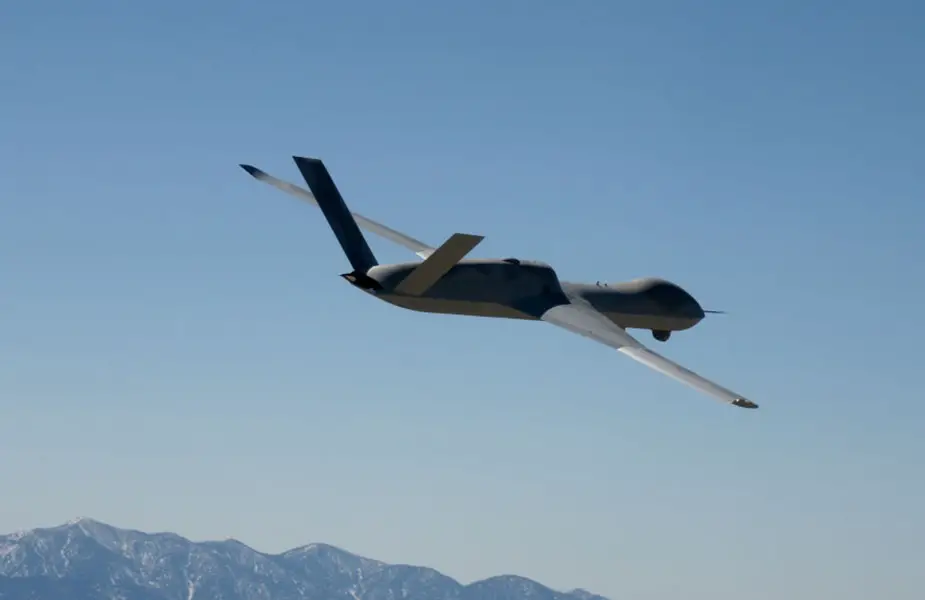Breaking news
GA-ASI pairs Avenger with virtual UAS to demo autonomous Search and Follow.
As part of the company’s commitment to develop advanced unmanned autonomy, General Atomics Aeronautical Systems, Inc. (GA-ASI) used a company-owned Avenger Unmanned Aircraft System and five hardware-in-the-loop synthetic Avengers to autonomously search and follow an artificially-generated adversary. The live-virtual swarm utilized a simulated Infrared Search and Track (IRST) sensor network in addition to the government-furnished CODE autonomy engine to accomplish the mission.
Follow Air Recognition on Google News at this link
 Avenger is a highly advanced, next-generation RPA. The jet-powered aircraft is equipped with a commercial Pratt & Whitney turbofan engine capable of producing over 5,000 pounds of thrust, resulting in a runway length requirement of under 5,000 feet. The engine is designed for greater fuel economy and features class-leading fuel consumption components. Avenger can operate at speeds up to 400 KTAS, at an altitude of over 50,000 feet, and 20+ hours of endurance. Its significant wing hard point payload mounting capacity enables it to carry multiple sensors, while its internal weapons bay can house 3,000 pounds of precision munitions or larger sensor payloads.(Picture source: GA-ASI)
Avenger is a highly advanced, next-generation RPA. The jet-powered aircraft is equipped with a commercial Pratt & Whitney turbofan engine capable of producing over 5,000 pounds of thrust, resulting in a runway length requirement of under 5,000 feet. The engine is designed for greater fuel economy and features class-leading fuel consumption components. Avenger can operate at speeds up to 400 KTAS, at an altitude of over 50,000 feet, and 20+ hours of endurance. Its significant wing hard point payload mounting capacity enables it to carry multiple sensors, while its internal weapons bay can house 3,000 pounds of precision munitions or larger sensor payloads.(Picture source: GA-ASI)
In the two-hour flight on January 28, 2022, the Avenger flew over the high desert of southern California. The live Avenger was commanded into a search mission with the five simulated Avengers. Once the simulated adversary entered the designated search area, the team of Avengers would decide, utilizing an AI/ML algorithm, which aircraft would autonomously break from the search-loiter and perform complex behaviors to show closed loop, air-to-air tactics.
“The flight demonstrated GA-ASI’s unique ability to deploy autonomy using a blend of simulated threats, real-world sensors, and live aircraft. GA-ASI’s robust autonomy pipeline provided seamless digital environments, UAV digital twins and machine learning to validate unmanned aircraft closing complex kill chains. This framework allows the DoD to rapidly transition next-generation, operationally relevant air-to-air warfare technology from the lab to the battlespace,” said GA-ASI Senior Director of Advanced Programs Michael Atwood.
The Avenger UAS integrated a ZPX-R ADS-B and Mode 5 Level 2 receiver provided by uAvionix. The low size, weight, and power (SWAP) sensor allowed the platform to track active aircraft within the local airspace. In addition to the live ADS-B/Mode 5 L2 sensor tracks being downlinked, the Advanced Framework for Simulation, Integration, and Modeling (AFSIM) software simulated two separate types of IRST sensors (situational and long-range). This allowed the multi-physics sensor network to downlink into the Common Operating Picture (COP) running on a government standard Human-Machine Interface. To complement the live-flying sensor suite, the Avenger also operated with All-Source Track and Identity Fuser (ATIF), a government-owned Multi-Physics Fusion engine.


























